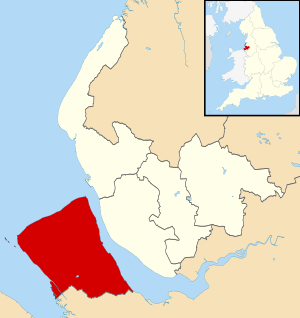Metropolitan Borough of Wirral facts for kids
Quick facts for kids
Wirral
|
||
|---|---|---|

Wallasey Town Hall
|
||
|
||

Wirral shown within Merseyside
|
||
| Sovereign state | ||
| Constituent country | ||
| Region | North West England | |
| City region | Liverpool | |
| Ceremonial county | Merseyside | |
| Established | 1 April 1974 | |
| Administrative HQ | Wallasey (Town Hall) | |
| Government | ||
| • Type | Metropolitan Borough | |
| • Body | Wirral Council | |
| Area | ||
| • Total | 60.6 sq mi (157.0 km2) | |
| Area rank | 185th | |
| Population
(2005 est.)
|
||
| • Total | 324,011 | |
| • Rank | Ranked 34th | |
| • Ethnicity | 98.3% white | |
| Demonym(s) | Wirralian | |
| Time zone | UTC+0 (Greenwich Mean Time) | |
| • Summer (DST) | UTC+1 (British Summer Time) | |
| Postcode area |
CH
|
|
| Dialling code | 0151 | |
| ISO 3166 code | GB-WRL | |
| GSS code | E08000015 | |
| NUTS 3 code | UKD74 | |
| ONS code | 00CB | |
| Website | www.wirral.gov.uk | |
The Metropolitan Borough of Wirral is a metropolitan borough of Merseyside, in North West England. It has a population of 321,238, and encompasses 60 square miles (160 km2) of the northern part of the Wirral Peninsula. Major settlements include Birkenhead, Wallasey, Bebington, Heswall, Hoylake and West Kirby. The city of Liverpool faces the northeastern side of Wirral over the Mersey.
Contents
History
The borough was formed on 1 April 1974, under the Local Government Act 1972, as a merger of the county boroughs of Birkenhead and Wallasey, along with the municipal borough of Bebington and the urban districts of Hoylake and Wirral.
Places of interest
Wirral Council maintains five designated Local Nature Reserves: Bidston Moss, Dibbinsdale, Heswall Dales, Hilbre Island and Thurstaston Common. It also operates the Merseyside part of Wirral Country Park, which was the first country park to be established in Britain.
International relations
Twin towns — sister cities
The Metropolitan Borough of Wirral is twinned or has sister city relationships with:
Economy
This is a chart of trend of regional gross value added of Wirral at current basic prices published (pp. 240–253) by Office for National Statistics with figures in millions of British Pounds Sterling.
| Year | Regional Gross Value Added | Agriculture | Industry | Services |
|---|---|---|---|---|
| 1995 | 2,089 | 10 | 674 | 1,405 |
| 2000 | 2,609 | 5 | 814 | 1,789 |
| 2003 | 3,020 | 9 | 755 | 2,256 |
includes hunting and forestry
includes energy and construction
includes financial intermediation services indirectly measured
Components may not sum to totals due to rounding
In September 2006 a large scale development called Wirral Waters was unveiled by the company Peel Holdings, that if constructed as outlined may see the creation of up to 27,000 jobs.
Education
When the borough was set up in 1974, it inherited comprehensive systems from the former County Boroughs of Birkenhead and Wallasey. In the part of Wirral formerly administered by Cheshire County Council, it inherited a selective system of grammar and secondary modern non-Roman Catholic schools and a comprehensive Roman Catholic school (St John Plessington Catholic College).
Until the implementation of the Education Reform Act 1988, education in Wirral continued to be organised in four areas; Birkenhead, Wallasey and the former parts of Cheshire known for education purposes as "Bebington" and "Deeside". However this Act introduced "open enrolment", allowing parents from anywhere in the borough, and outside it, to apply for a place for their child at any secondary school. As a result, significant numbers of pupils from the former "comprehensive areas" attend schools in the former "selective areas" and vice versa. The distinction between different types of school was to an extent masked, as all secondary modern and most comprehensive schools were named "High School". As a further result of this Act, St Anselm's College and Upton Hall School, both within the Birkenhead education area, became the only independent schools in the country to become state funded grant-maintained schools, retaining selective admissions policies to become Roman Catholic grammar schools.
A further change came as a result of the School Standards and Framework Act 1998, which effectively changed secondary modern schools into comprehensives as schools were no longer permitted to select by examination failure. In summary, Wirral now has a state secondary sector made up of 16 comprehensive schools (of which two are Roman Catholic) and 6 grammar schools (of which two are Roman Catholic).


